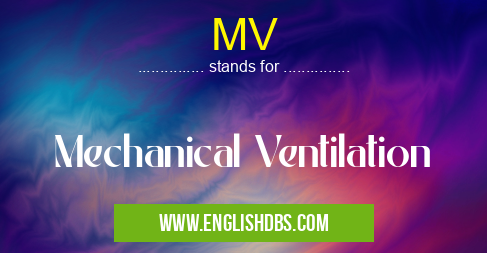What does MV mean in MEDICAL
MV is a commonly used abbreviation in the medical field that stands for Mechanical Ventilation. It refers to the use of a medical device to assist or replace a patient's breathing. Mechanical ventilation is employed when a patient is unable to breathe adequately on their own, typically due to conditions such as respiratory failure, severe lung injury, or neuromuscular disorders.

MV meaning in Medical in Medical
MV mostly used in an acronym Medical in Category Medical that means Mechanical Ventilation
Shorthand: MV,
Full Form: Mechanical Ventilation
For more information of "Mechanical Ventilation", see the section below.
What Does MV Stand For?
MV stands for:
- Mechanical Ventilation
MV Meaning in Medical
In medical terminology, MV refers to the process of providing respiratory support to a patient through the use of a mechanical ventilator. The ventilator is connected to the patient's airway through a tube inserted either through the mouth (orotracheal intubation) or the nose (nasotracheal intubation). The ventilator delivers pressurized air or a mixture of gases to the patient's lungs, assisting or completely taking over the breathing process.
Importance of MV
Mechanical ventilation plays a crucial role in critical care medicine. It provides life-sustaining respiratory support to patients who are unable to breathe independently. MV helps maintain adequate oxygen levels in the blood and removes carbon dioxide, preventing respiratory failure and its associated complications.
Essential Questions and Answers on Mechanical Ventilation in "MEDICAL»MEDICAL"
What is Mechanical Ventilation (MV)?
MV is a medical procedure that involves using a machine (ventilator) to help a patient breathe. It is used when a person is unable to breathe adequately on their own, such as in cases of severe respiratory failure, injury, or during surgery.
What are the different types of Mechanical Ventilation?
There are two main types of MV: invasive and non-invasive. Invasive MV requires insertion of a breathing tube (endotracheal tube) into the trachea (windpipe). Non-invasive MV uses a mask or nasal prongs to deliver air without intubation.
When is Mechanical Ventilation necessary?
MV is necessary when a patient's respiratory function is compromised and they cannot maintain adequate oxygen and carbon dioxide levels in their blood. It may be required in conditions such as:
- Severe pneumonia
- Acute respiratory distress syndrome (ARDS)
- Chronic obstructive pulmonary disease (COPD)
- Sleep apnea
- Drug overdose
What are the potential benefits of Mechanical Ventilation?
MV can provide life-saving support by:
- Improving oxygen delivery to the body
- Removing carbon dioxide from the blood
- Reducing the work of breathing
- Allowing for sedation or anesthesia
What are the potential risks and complications of Mechanical Ventilation?
MV carries potential risks, including:
- Ventilator-associated pneumonia (VAP)
- Lung damage
- Barotrauma (injury caused by air pressure)
- Pneumothorax (collapsed lung)
- Bleeding or trauma from intubation
Final Words: MV, or Mechanical Ventilation, is a vital medical intervention that assists or replaces a patient's breathing. It is employed in critical situations when patients are unable to breathe adequately on their own. Mechanical ventilation provides respiratory support, maintains oxygenation, and removes carbon dioxide, helping to improve patient outcomes and prevent life-threatening complications.
MV also stands for: |
|
| All stands for MV |
